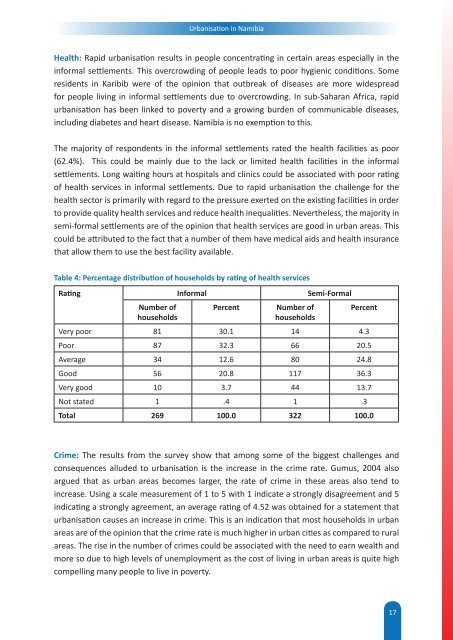Urbanisation-in-Namibia
Urbanisation-in-Namibia
Urbanisation-in-Namibia
Create successful ePaper yourself
Turn your PDF publications into a flip-book with our unique Google optimized e-Paper software.
<strong>Urbanisation</strong> <strong>in</strong> <strong>Namibia</strong>Health: Rapid urbanisation results <strong>in</strong> people concentrat<strong>in</strong>g <strong>in</strong> certa<strong>in</strong> areas especially <strong>in</strong> the<strong>in</strong>formal settlements. This overcrowd<strong>in</strong>g of people leads to poor hygienic conditions. Someresidents <strong>in</strong> Karibib were of the op<strong>in</strong>ion that outbreak of diseases are more widespreadfor people liv<strong>in</strong>g <strong>in</strong> <strong>in</strong>formal settlements due to overcrowd<strong>in</strong>g. In sub-Saharan Africa, rapidurbanisation has been l<strong>in</strong>ked to poverty and a grow<strong>in</strong>g burden of communicable diseases,<strong>in</strong>clud<strong>in</strong>g diabetes and heart disease. <strong>Namibia</strong> is no exemption to this.The majority of respondents <strong>in</strong> the <strong>in</strong>formal settlements rated the health facilities as poor(62.4%). This could be ma<strong>in</strong>ly due to the lack or limited health facilities <strong>in</strong> the <strong>in</strong>formalsettlements. Long wait<strong>in</strong>g hours at hospitals and cl<strong>in</strong>ics could be associated with poor rat<strong>in</strong>gof health services <strong>in</strong> <strong>in</strong>formal settlements. Due to rapid urbanisation the challenge for thehealth sector is primarily with regard to the pressure exerted on the exist<strong>in</strong>g facilities <strong>in</strong> orderto provide quality health services and reduce health <strong>in</strong>equalities. Nevertheless, the majority <strong>in</strong>semi-formal settlements are of the op<strong>in</strong>ion that health services are good <strong>in</strong> urban areas. Thiscould be attributed to the fact that a number of them have medical aids and health <strong>in</strong>surancethat allow them to use the best facility available.Table 4: Percentage distribution of households by rat<strong>in</strong>g of health servicesRat<strong>in</strong>g Informal Semi-FormalNumber ofhouseholdsPercentNumber ofhouseholdsPercentVery poor 81 30.1 14 4.3Poor 87 32.3 66 20.5Average 34 12.6 80 24.8Good 56 20.8 117 36.3Very good 10 3.7 44 13.7Not stated 1 .4 1 .3Total 269 100.0 322 100.0Crime: The results from the survey show that among some of the biggest challenges andconsequences alluded to urbanisation is the <strong>in</strong>crease <strong>in</strong> the crime rate. Gumus, 2004 alsoargued that as urban areas becomes larger, the rate of crime <strong>in</strong> these areas also tend to<strong>in</strong>crease. Us<strong>in</strong>g a scale measurement of 1 to 5 with 1 <strong>in</strong>dicate a strongly disagreement and 5<strong>in</strong>dicat<strong>in</strong>g a strongly agreement, an average rat<strong>in</strong>g of 4.52 was obta<strong>in</strong>ed for a statement thaturbanisation causes an <strong>in</strong>crease <strong>in</strong> crime. This is an <strong>in</strong>dication that most households <strong>in</strong> urbanareas are of the op<strong>in</strong>ion that the crime rate is much higher <strong>in</strong> urban cities as compared to ruralareas. The rise <strong>in</strong> the number of crimes could be associated with the need to earn wealth andmore so due to high levels of unemployment as the cost of liv<strong>in</strong>g <strong>in</strong> urban areas is quite highcompell<strong>in</strong>g many people to live <strong>in</strong> poverty.17


